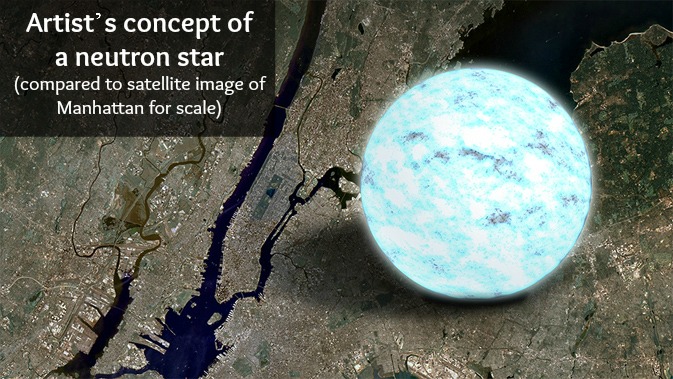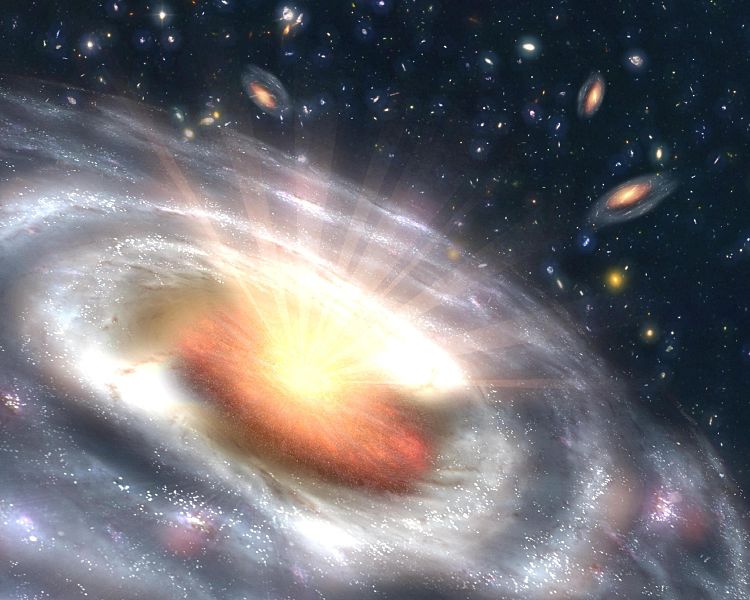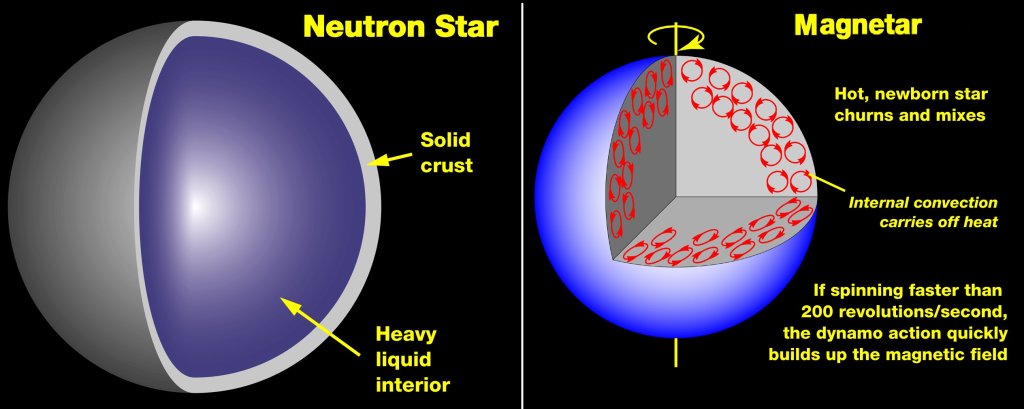
What are quasars?
When radio telescopes were first turned onto the heavens in the 1940’s, radio sources were found all over the place. We were getting some kind of radio signal from almost every direction. You can imagine what some people thought. One of the more interesting ideas was that there was an armada of alien ships out there talking to one another. Astronomers turned their ordinary visible-light telescopes to these radio sources to try to see what was giving off the radio signals (and hoped they wouldn’t see little green men waving back at them).
They found a lot of different things, but no aliens. They found some supernova remnants, star forming regions, and distant galaxies. But there were other odd objects that they discovered that were not so easily classified. These objects looked like tiny dots of light in the sky (like a star does when looking with just our eyes); however, we were looking through massive telescopes and getting goose egg for detail. Because the objects were so blurry, that could only mean that these were mind numbingly far away. The Hubble Telescope has them ranging from 2.6 to 16 billion light-years away.
And this is how we discovered quasars.

Quasar actually stands for Quasi-Stellar Radio Source, but that’s quite a mouthful, so we call them quasars for short. Quasi-Stellar Radio Source also sounds really complex, but when you translate it to simple English, it’s really not. Radio and Source are self-explanatory, but Quasi-Stellar just means star-like. Basically, what we’re talking about is something that looks like a star and gives off a radio signal. Once translated, the names of these things are notoriously uncreative.
Quasars are now believed to be the very bright centers of distant galaxies. Each quasar is many times brighter than our entire galaxy of 200 billion stars. The Quasars are also only about a light day or so across, which is about the size of our solar system. So, if you take its size, and consider how bright it is, a quasar emits baffling amounts of energy. One of the only energy sources strong enough to power quasars are supermassive black holes (black holes with the mass of about a million times the mass of the Sun). These black holes are surrounded by a cloud of rotating dust and gas. As material falls into the black hole, it is heated to millions of degrees, which is spread across the spectrum from radio waves, to visible light, to gamma rays. Compressed to one sentence, a quasar is a shell of super-heated gas surrounding a supermassive black hole.
Even though quasars are named after their radio emissions, only about 10% of the known quasars send out substantial amounts of radio waves. Lovely. So, we now call those “Radio Loud Quasars. “ Usually, the particle jets coming off the central black hole are what create the radio signals, which would explain the low amount of Radio Loud Quasars. The jets of the other galaxies just aren’t pointed at us.
So how are Quasars formed? The short answer is…we don’t know. There are no more quasars for us to study as they form. It is believed they form as a galaxy forms. And with the closest known quasar being 800 million light years away, the youngest quasar is 800 million years old, and none have formed since. Where did they go? No one knows for sure. Some people think the black hole ate all the dust and gas, leaving nothing for the quasar to have, and ceased to exist.
One theory about potentially new Quasar formation was that Quasars first formed through colliding galaxies. Now galaxies colliding into one another are massive collisions. You have the dust and gas from two fully fledged galaxies merging, as well as their central black holes. That’s a whole lot of additional matter to fall towards that new bigger black hole to create some pretty interesting particle jets, and start a new Quasar. The problem is that not many big galaxies are colliding, and fast enough comparatively for us to study a Quasar forming in our, or several lifetimes.
What are Neutron Stars?
Neutron stars are formed as a large star dies in a Type II Supernovae. The Supernovae blows off much of the star, and you are left with the collapsed iron core of a star (this happens to stars that have a mass about 8 to about 25 times the mass of the Sun). The remaining iron core collapses down to about 20 kilometers wide, but it still maintains a mass between 1.5 to 5 times the mass of our Sun (a pretty impressive little thing, no?). Neutron stars are typically about 20 kilometers or so, about the size of a decent sized city. Think about that for a second, something more massive than the sun the size of a city. You can imagine the Neutron star is immensely dense. So dense, a teaspoon sized Neutron star matter would weigh about 100 million tons! The crust of the Neutron star would also be about 100 billion times stronger than steel.
Why do we call them “neutron stars”? Fist. neutrons are the uncharged, neutral particles in the middle of atoms. But why did we name the star after those tiny, tiny particles? Well, because the star is made up of neutrons.

First, no, the protons and electrons didn’t decide to leave the star, leaving the neutrons to pick up the pieces after being dumped by both its atomic partners. Rather, the star is basically one giant atom made up of nothing but neutrons. As the star collapses, the mass of the star creates so much gravity that the protons and electrons fuse together. Now, what happens when you add one positive and one negative number? That’s right, nothing. We’re left with one neutrally charged particle. A Neutron. Like I said with the quasars, these names are notoriously uncreative.
It takes some pretty powerful gravity to fuse protons and electrons. So powerful, in fact, that if you were to drop a marshmallow on the star, it would hit with an impact of a thousand nuclear bombs. So strong that, if you were to stand on the surface of a Neutron star, you would be crushed into a paste a few atoms thick.
What are Pulsars?
This is going to sound odd while talking about dying stars, black holes, and neutrons, but I’m going to talk about a figure skater for a minute. Yeah, odd, but bear with me…
Let’s say our figure skater goes into a spin. Typically, a skater starts off with her arms and one leg spread out. As she draws her arms and leg in towards her body, she starts spinning faster and faster. This is an example of the Law of Angular Momentum, which a complex way to say– when something spins and shrinks in size, but keeps the same mass, the object spins faster. The same happens with a Neutron star. The star has shrunk in size, but maintained its mass, so it spins very fast. The record speed is 1122 rotations in one second, with the record slowest speed is one rotation in 4.308 seconds.
Now, a Neutron star has a solid core and a “liquid” mantle. Its crust is only about an inch thick, but the solid core and “liquid” mantle gives the star a magnetic field, and with its mass and density, the field is about a trillion times as strong as Earth’s. Neutron stars emit high-energy beams at its North and South magnetic poles, which is usually made from material from a companion star. If these beams are pointed at Earth, as the Neutron star rotates, they seem to pulse. So we came up with the name Pulsar. Again, uncreative.
So, all Pulsars are Neutron stars, but not all Neutron stars are Pulsars. All depends on which way its energy beams are pointing.
What are Magnetars?
Magnetars are a type of neutron star, like pulsars, but with a magnetic field on serious steroids. Although not much is known about them, it is believed that magnetars are a type of neutron star that were made during a Supernova explosion, similar to that of a pulsar. They are one of the most dense objects in the universe. It is theorized that the dynamo mechanism may be the reason to their formation. Basically, if the spin, temperature and the magnetic field of a neutron star are within the right ranges it can convert the heat and rotational energy into very strong magnetic energy.
Although neutron stars and a magnetar are similar in formation they hold very different characteristics which sets them apart from each other. For instance magnetars rotate at a very slower rate, usually once every 8 to 10 seconds as opposed to one or more rotations a second for neutron stars. Another difference between a magnetar and a neutron star is that a magnetar emits a steady glow of x-rays with more radiant power than could be supplied by the rotation of a neutron star. The magnetic fields made by a magnetar are about 1,000 trillion that of the Earth’s magnetic field and can reach surface temperatures of 18 million degrees Fahrenheit.

Magnetars have a magnetic field around 100 times stronger than your average neutron star, which is already staggeringly strong. For comparison magnetars can have a grand total of one quadrillion times the strength of Earth’s magnetic field. What does that mean? That means that Magnetars are the most magnetic object in the known universe.
Alright, Magnetars are giant magnets. How strong are they? Well, let’s say a Magnetar was at about the distance from the Earth is as the moon. Good bye credit cards. At that distance, the magnetic strip on the backs of every credit card on Earth is wiped clean. Cut that distance in half, and metal objects are lifted off the Earth. If say…a Rogue Magnetar was to come within 600 miles of Earth. At that distance, the iron would be sucked from our bodies (a rather painful process, I’m afraid). Like I said, Magnetars are cool.